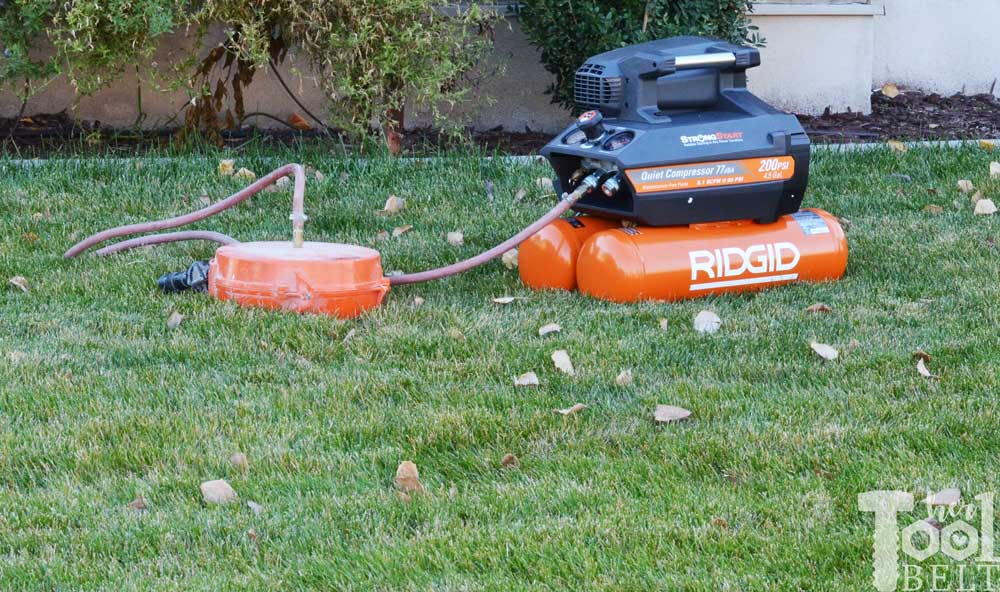For blowing out sprinklers, a compressor with at least 50-80 cubic feet per minute (CFM) is typically recommended. This ensures sufficient air volume to effectively blow out the water from the system.
Winterizing your sprinkler system is crucial to prevent freezing and damage during the colder months. Using a compressor to blow out the water from the system helps to eliminate potential freezing, which can cause costly damage. However, the size of the compressor needed depends on the size and complexity of your sprinkler system.
We will explore the factors to consider when selecting the right size compressor for blowing out your sprinklers, as well as additional tips for effectively winterizing your irrigation system. By understanding the requirements and best practices for winterizing your sprinkler system, you can ensure its longevity and optimal performance.
What Size Compressor For Blowing Out Sprinklers
Choosing the correct size compressor is crucial for effectively blowing out sprinkler systems. The size of the compressor dictates the pressure and volume of air it can produce, and this greatly impacts the efficiency of the sprinkler blowout process. If the compressor is too small, it may not generate enough airflow to clear out all the water from the system, potentially leading to freezing and damage. On the other hand, if the compressor is too large, it can cause excessive pressure that might damage the system. It’s important to consider the number of zones and the type and size of the sprinkler heads when selecting the compressor size. Consult the manufacturer’s guidelines or seek advice from a professional to ensure the correct size is chosen for blowing out your sprinklers.
Air Flow Requirements
When selecting a compressor for blowing out sprinklers, it’s crucial to consider the air flow requirements. The cubic feet per minute (CFM) and pressure requirements in pounds per square inch (PSI) are essential factors to determine the appropriate compressor size. The CFM requirement varies depending on the size and complexity of the sprinkler system. Typically, a CFM of 20-50 is adequate for residential sprinkler systems, while larger commercial systems may require a higher CFM. As for the PSI, most sprinkler systems need around 50-80 PSI to effectively blow out the water from the pipes. It’s important to match the compressor’s CFM and PSI capacity with the specific requirements of the sprinkler system to ensure efficient blowout without causing any damage.
Tank Volume Consideration
When choosing a compressor for blowing out sprinklers, it’s important to consider the tank volume. For residential jobs, a compressor with a gallon capacity of 20 to 30 gallons is typically sufficient. These sizes offer enough air to effectively clear the sprinkler lines without being too cumbersome for residential use. On the other hand, larger tanks with a capacity of 60 gallons or more are better suited for commercial projects, where a greater volume of air is needed to tackle larger systems. By selecting the appropriate gallon capacity for your specific job, you can ensure efficient and effective sprinkler system maintenance.
Portable Air Compressors
Portable air compressors offer the advantage of mobility and ease of use, making them ideal for blowing out sprinklers. When determining the right size compressor, it’s essential to consider the impact of size variations on performance. A larger compressor will provide more power and allow for faster completion of the task, while a smaller one may require more time to complete the job. Understanding the specific requirements of your sprinkler system is crucial in selecting the appropriate compressor size for optimal efficiency.
Stationary Air Compressors
For blowing out sprinklers, the size of the compressor you need will depend on several factors. If you are considering a stationary air compressor, it’s important to assess the space and power supply where the compressor will be located. Consider the available space and location for the compressor, as well as the power source and electrical requirements. You will also need to take into account the cubic feet per minute (CFM) requirement for effectively blowing out sprinklers. It’s essential to choose a compressor with the adequate CFM rating to ensure efficient operation when blowing out sprinklers.
Residential Sprinkler Setups
When setting up a residential sprinkler system, it’s vital to choose the right size compressor for efficiently blowing out the sprinklers. The right compressor size will ensure proper maintenance and prevent damage to the system during winterization. Be sure to select a compressor that matches the specific requirements of your sprinkler setup to keep it in top condition.
| Residential Sprinkler Setups |
| When choosing a compressor for blowing out sprinkler systems, it’s essential to consider the typical CFM and PSI requirements. Typically, residential sprinkler systems require a compressor with a minimum of 50-80 CFM and 30-50 PSI to effectively blow out the water. Additionally, seasonal considerations play a significant role in determining the appropriate compressor size. For colder climates, a larger compressor with higher CFM and PSI may be necessary to ensure comprehensive winterization. In warmer climates, a smaller compressor may suffice. Proper sizing of the compressor is crucial for an efficient and successful sprinkler system blowout. |
Commercial Sprinkler Systems
When choosing a compressor for blowing out sprinklers in commercial sprinkler systems, it is crucial to consider the differences in capacity needs based on diverse landscape areas. The size of the compressor should be determined by the overall layout and size of the irrigation system. For larger landscapes or multi-zone systems, a high-capacity compressor is essential to ensure efficient air flow and adequate pressure. Conversely, smaller properties with fewer zones may require a smaller compressor that can still deliver the necessary air pressure. Considering the varying requirements of different landscape areas, it is important to consult with a professional to ensure the compressor size is suitable for the specific sprinkler system’s demands. Failure to use the correct size compressor can result in incomplete air blowout, leading to potential water damage and costly repairs.
Necessary Attachments And Adapters
Sure, I can help you with that. Below is the HTML representation of your blog post content:“`htmlWhen choosing a compressor for blowing out sprinklers, it’s essential to consider the necessary attachments and adapters. Hose diameter and connectors play a crucial role in ensuring a proper fit between the compressor and the sprinkler system. It’s important to select nozzles and inline dryers that are compatible with the compressor to effectively remove moisture from the system, preventing potential damage.
Safety Equipment And Best Practices
When selecting the right size compressor for blowing out sprinklers, it’s essential to prioritize safety equipment and best practices. Pressure regulators and gauges play a crucial role in ensuring safe operation during blowouts. By utilizing appropriate safety gear such as protective eyewear, gloves, and hearing protection, operators can mitigate potential risks during the process.
Pressure regulators help control the airflow, preventing excess pressure that could damage the sprinkler system. Gauges provide real-time monitoring of the pressure, allowing for adjustments as needed. Following best practices and adhering to safety guidelines is paramount when engaging in this essential maintenance activity. Properly maintained equipment and adherence to safety protocols will contribute to efficient and safe sprinkler blowouts.
Preparing Your System And Compressor
When preparing your sprinkler system and compressor for blowing out sprinklers, it is important to conduct initial checks and adjustments. Clearing and shutting off the water supply is a crucial step in this process. Ensuring proper preparation of your system and compressor will help in avoiding potential damage and ensuring a successful blowout. Carefully inspecting the system and making necessary adjustments will help in achieving optimal results. Taking time to clear any debris and shutting off the water supply will prevent any mishaps during the blowout process. Proper preparation will lay the groundwork for a smooth and efficient blowout of your sprinkler system using the right size compressor.
Blowing Out Each Zone
When it comes to blowing out sprinkler systems, it’s crucial to use the right size compressor for optimal results. Choosing the correct compressor size is essential for effectively blowing out each zone. A sequential approach ensures thoroughness. Start by blowing out the farthest zone to remove any water. Then move to the next closest zone. Continuously monitoring pressure levels throughout the process is important – this can prevent damage to the system. A pressure gauge should be used to ensure the pressure remains within safe limits. By following these steps and guidelines, the blowing out process can be conducted effectively and efficiently.

Credit: www.hertoolbelt.com
Post-blowout Steps
When blowing out sprinkler systems using an air compressor, it’s crucial to use the right size compressor for the job. A compressor with a minimum cubic feet per minute (CFM) rating of 80-100 is recommended for the task. Blowing out the sprinkler system with compressed air helps remove any remaining water, preventing freezing and damage to the pipes, valves, and fittings during the winter months. Post-blowout steps include draining the compressor to ensure its longevity and winterizing all sprinkler components to safeguard them from the harsh weather conditions. Remember to adjust the pressure to avoid damaging the system. Performing these steps properly will help ensure a trouble-free winterization process for your sprinkler system.
Frequently Asked Questions On What Size Compressor For Blowing Out Sprinklers
What Size Compressor Is Best For Blowing Out Sprinklers?
A compressor with at least 80-100 CFM (cubic feet per minute) and 50-80 PSI (pounds per square inch) is ideal for blowing out sprinklers. This ensures sufficient airflow and pressure to effectively clear water from the system without damaging the pipes.
How Do I Determine The Right Compressor Size For My Sprinklers?
To determine the right compressor size, calculate the total volume of air needed for your sprinkler system and ensure the compressor can provide enough CFM and PSI to match this volume. Factors such as pipe diameter and length, as well as pressure requirements, should be considered.
Can I Use A Smaller Compressor For Blowing Out Sprinklers?
Using a smaller compressor may not provide enough airflow and pressure to effectively clear the sprinkler system, potentially leaving water trapped and leading to costly repairs. It’s recommended to use a compressor with the minimum required CFM and PSI to ensure proper blowout.
What Are The Consequences Of Using An Undersized Compressor For Blowout?
Using an undersized compressor can result in inadequate pressure, leading to incomplete water removal and potential freezing or damage to the sprinkler system. It may also cause unnecessary strain on the compressor, reducing its lifespan and performance. Therefore, using the right size is crucial for preserving the system.
Conclusion
Choosing the right size compressor for blowing out sprinklers is crucial for efficient maintenance. Understanding the specific requirements of your sprinkler system and the appropriate air pressure is essential. By following these guidelines, you can ensure that your sprinkler system is properly winterized, preventing potential damage and costly repairs.

